小学英语四年级一般疑问句的知识ppt
小学英语一般疑问句PPT课件
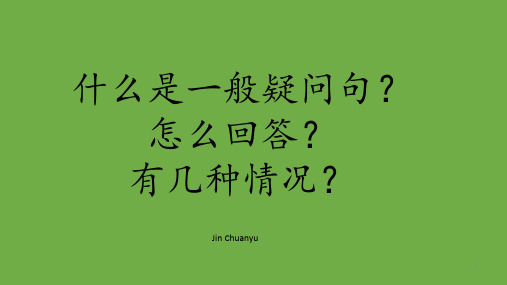
1. ___________________________________?
Yes, there is a bookstore next to the school.
2. ____________________________________?
Yes, there are some pandas in the mountains.
Do you go to bed at nine o’clock?
.
4
5 I will go back in two days.
Will you go back in two days?
6 He can play football. Can he play football?
7 The children are singing.
1 be动词: am, is, are, was, were
2 情态动词: can, may,will,must ,shall,should,could, might, would,need, …
3 助动词: do does did has/have(已经)
注意:
some在否定句, 疑问句中 要变成 any
4. Can your mother play the pipa?
No, _______ _______.
5 .May I have a look?
_____, ______ ______ ______(肯. 定)
9
二、根据图片回答问题.
1Are you watching TV? _________________.
2.Is he short and strong? ___________________.
小学英语语法课件-疑问句 (共29张PPT) 全国通用
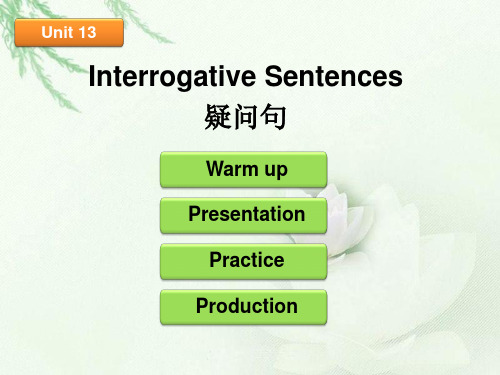
Presentation Grammar Box
Presentation Grammar Box
Presentation Grammar Box
Presentation Grammar Box
Presentation Grammar Box
Presentation Grammar Box
A. What
B. When
C. Where
D. Which
Production Quiz
Production Quiz
Practice Oral Practice
选择正确的答语。
A. By car. B. Yes, she has. C. Yes, I do. D. It’ s 10 dollars. E. He is my brother.
( E) 1. Who is he? ( A) 2. Do you go home by car or by subway?
Practice
Exercise 2
aren't you
Practice
Exercise 3
Practice
Exercise 4
5
PPrraaccttiicceeI Exercise 1
特殊疑问句 一般疑问句 一般疑问句 一般疑问句 反意疑问句
Practice
Exercise 2
aren't you didn’t she
My grandma has been to many places, _h_a_s_n_’_t _s_h_e_? Lily and Lucy will go to school next week, _w__o_n_’_t _th_e_y__?
小学英语语法---一般疑问句和特殊疑问句ppt课件
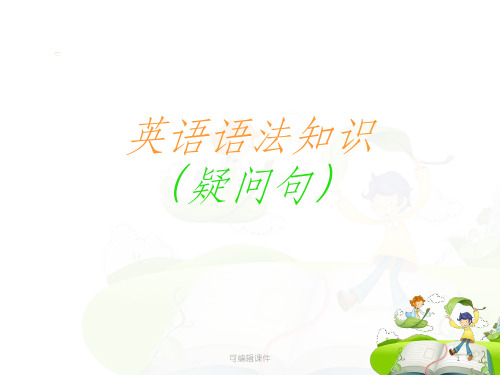
可编辑课件
4
e.g
This is Amy's bike.(一般疑问句)
Is this Amy's bike?
Yes, this is. (肯定回答)错误
No, this isn‘t. (否定回答)错误
Did you go to Beijing last weekend?
Yes, I did. (肯定回答)
2、如句子里是动词就在这些词前加 don't,doesn't,didn't
(1)主语是第一、二人称(复数)加don’t,第三人称单数加
doesn't
(2)如果是过去式就加didn't
例:I like dogs.
She likes swimming.
I don‘t like dogs.
She doesn’t like swimming.
No, I didn't. (否定回答)
I have some books. (一般疑问句)
Do you have any b可o编辑o课件ks?
5
变否定句的做法:
1、如句子里是be动词:am,is,are,was,were 就在这些词后加 not
例: He is Tom.
He is not Tom.
( B) 25. ______ tea did you have?
Two cups. • How many B. How much C. How soon D. Which
可编辑课件
15
感谢亲观看此幻灯片,此课件部分内容来源于网络, 如有侵权请及时联系我们删除,谢谢配合!
感 谢 阅
读感
谢
小学英语改一般疑问句PPT课件
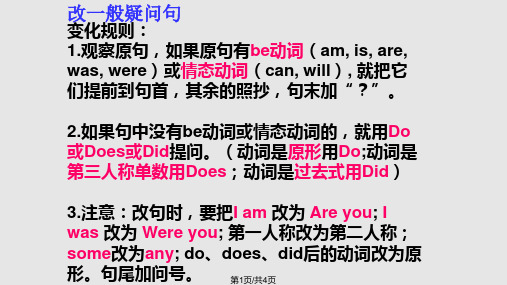
__C__a_n_____ __h__e______ swim?
(3) Lingling likes apples.
_D_o_e_s__ Lingling _l_ik_e___ appleng list.
_W_i_l_l __ __y_o_u___ make a shopping list?
改一般疑问句
变化规则: 1.观察原句,如果原句有be动词(am, is, are, was, were)或情态动词(can, will), 就把它 们提前到句首,其余的照抄,句末加“?”。
2.如果句中没有be动词或情态动词的,就用Do 或Does或Did提问。(动词是原形用Do;动词是 第三人称单数用Does;动词是过去式用Did)
(5) Amy bought some pears yesterday.
_D_i_d_ Amy b__u_y_ a__n_y_ pears yesterday?
第2页/共4页
第3页/共4页
感谢您的观看!
第4页/共4页
3.注意:改句时,要把I am 改为 Are you; I was 改为 Were you; 第一人称改为第二人称; some改为any; do、does、did后的动词改为原 形。句尾加问号。 第1页/共4页
把下列句子改为一般疑问句。
(1)I am a good student.
_A_r_e____ __y_o__u__ a good student?
小学英语一般疑问句讲解ppt课件

特别注意:对于第二家族一定要注意动词的还原,因为时态与数的变 化已经体现在助动词上了。
14
加强记忆口诀: “肯变一,并不难,can 或be提在前; 谓语若为行为动,do 或does句首用。”
15
特殊疑问句
以特殊疑问词开头,对陈述句中的某一部分提出疑问 / 进行发问的句子叫特殊疑问句。
一句话: wh-开头外加能与之结伴同行的名词; how及它的形容词兄弟姐妹们, 即如: What(什么),why(为什么),who(谁), where(哪里), which(哪一个), what class(什么课), what time(什么时间), what number(什么号码); how(怎么样),how many(多少), how old(多大), how much(多少)等。
must 必须 Must I go to school every day?
need 需要 Need I do my homework now?
shall 表示征求对方意见,意为“要不要。。。?“ ”。。。 好吗?” Shall we go out for a walk?
7
二、一般疑问句的结构
含情态动词的一般疑问句,其结构为: 情态动词 + 主语 + 动词原形+其它部分?
9
二、一般疑问句的结构
含行为动词(或称为实义动词)的一般疑问句, 其结构为: 助动词 + 主语 + 动词原形 + 其它?
小学四年级英语下册一般疑问句特殊疑问句PPT课件
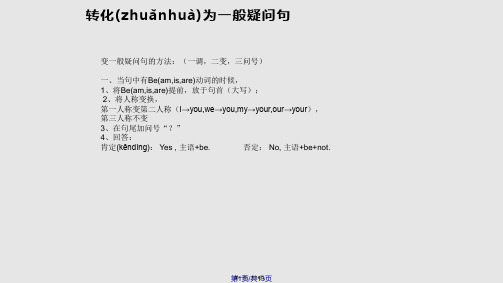
→what colour are My sister's trousers?
This orange shirt is Lulu's. →is This orange shirt Lulu's. →whose is This orange shirt. →Whose is this orange shirt?
第第5五页页,/共共141页3。页
play computer games everyday. →Do play computer games everyday. →Do play computer games everyday?
plays computer games everyday.
→Do plays computer games everyday. →Does play computer games everyday?
感谢您的观看(guānkàn)!
第第1十3三页页,/共共114页3。页
内容(nèiróng)总结
转化为一般疑问句。一、当句中有Be(am,is,are)动词的时候,。1、将Be(am,is,are)提前,放于句首(大写)。第 一人称变第二人称(I→you,we→you,my→your,our→your),。2、将人称变换(biànhuàn),第一人称变第二人称(
1.who is that boy?那个男孩是谁?2. who are you ? 你是谁?3. Who is that pretty lady?那个漂亮的女士 是谁?
1. whose bag is this? 这是谁的包? 2.whose bike is yellow? 谁的自行车是黄色的?
四年级一般疑问句

肯定句
I am tall.
I am a girl.
we are strong.
一般疑问句
Are you tall?
肯定回答:Yes,I am. 否定回答:No,I am not.
Are you a girl?
肯定回答:Yes,I am. 否定回答:No,I am not.
Are you strong?
肯定回答:Yes,we are. 否定回答:No,we aren't.
肯定句 变 一般疑问句
1.找到be(am,is,are)动词,把be提前
2.看到is,就把is提前放句首,首字母大写Is 看到are,就把are提前放句首,首字母大写Are
3.句子结尾加问号“?”
看到I am或We are,要改成Are you.....? (第一人称改第二人称,be动词也要随着改变)
如果有人问你,你今年是九岁吗? 你会怎么回答?
你一定会说,是或者不是。
这种只回答“是”或者“不是”的问句, 在英语中叫做一般疑问句。
肯定句
一般疑问句
It is a bag.
Is
it
a
bag?Biblioteka Yes,it is. 肯定回答 No,it isn't.否定回答
Jim is six.
Is
Jim
six?
Yes,he is. 肯定回答 No,he isn't.否定回答
4.肯定回答用Yes,it/she /he is./ Yes,we/they are. Yes, I am. 否定回答用No,it/she /he isn't. No,we/they aren't. No,I am not.(前后关系要一致)
小学英语语法PPT课件
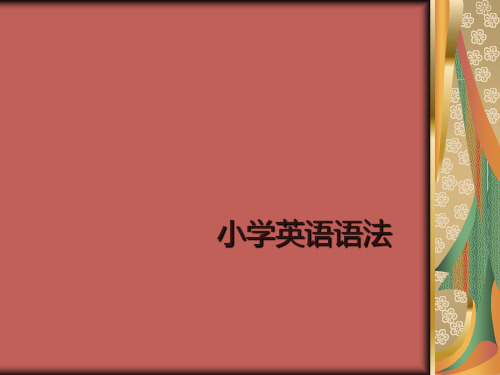
五、对划线部分提问。一般情况,一般将来时的对划线 部分有三种情况。 1、问人。Who 例如:I‟m going to New York soon. →Who‟s going to New York soon. 2、问干什么。What … do.例如: My father is going to watch a race with me this afternoon. →What is your father going to do with you this afternoon. 3、问什么时候。When.例如:She‟s going to go to bed at nine. →When is she going to bed? 六、同义句:be going to = will I am going to go swimming tomorrow(明天). = I will go
2.行为动词的变化。 否定句:主语 don„t( doesn‟t ) 动词原形( 其它)。 如: I don't like bread. 当主语为第三人称单数,用doesn„t构成否定句 如:He doesn't often play. 一般疑问句:Do( Does ) 主语 动词原形 其它。 如- Do you often play football? - Yes, I do. / No, I don't. 当主语为第三人称单数,要用does构成一般疑问句 如 -Does she go to work by bike? - Yes, she does. / No, she doesn't.
小学英语语法
名词复数规则
1.一般情况下,直接加-s,如:book-books, bag-bags, cat-cats, bed-beds 2.以s. x. sh. ch结尾,加-es, 如:bus-buses, box-boxes, brushbrushes, watch-watches 3.以“辅音字母 y”结尾,变y为i, 再加-es, 如:family-families, strawberrystrawberries
最新PEP小学四年级英语下册一般疑问句和特殊疑问句知识精讲
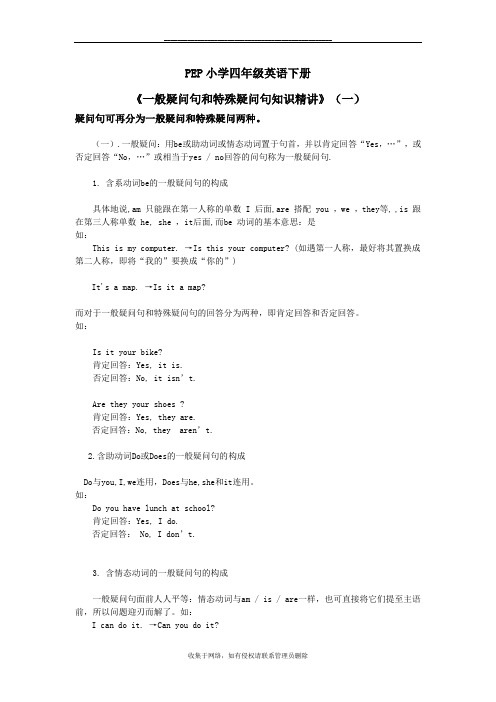
PEP小学四年级英语下册《一般疑问句和特殊疑问句知识精讲》(一)疑问句可再分为一般疑问和特殊疑问两种。
(一).一般疑问:用be或助动词或情态动词置于句首,并以肯定回答“Yes,…”,或否定回答“No,…”或相当于yes / no回答的问句称为一般疑问句.1. 含系动词be的一般疑问句的构成具体地说,am 只能跟在第一人称的单数 I 后面,are 搭配 you ,we ,they等, ,is 跟在第三人称单数 he, she ,it后面,而be 动词的基本意思:是如:This is my computer. →Is this your computer? (如遇第一人称,最好将其置换成第二人称,即将“我的”要换成“你的”)It's a map. →Is it a map?而对于一般疑问句和特殊疑问句的回答分为两种,即肯定回答和否定回答。
如:Is it your bike?肯定回答:Yes, it is.否定回答:No, it isn’t.Are they your shoes ?肯定回答:Yes, they are.否定回答:No, they are n’t.2.含助动词Do或Does的一般疑问句的构成Do与you,I,we连用,Does与he,she和it连用。
如:Do you have lunch at school?肯定回答:Yes, I do.否定回答:No, I don’t.3. 含情态动词的一般疑问句的构成一般疑问句面前人人平等:情态动词与am / is / are一样,也可直接将它们提至主语前,所以问题迎刃而解了。
如:I can do it. →Can you do it?肯定回答:Yes,I can.否定回答:No, I can’t.(记住在改成一般疑问句时应该将第一人称改成第二人称)Can I wear my new shirt today?肯定回答:Yes,you can.否定回答:No, you can’t.4. 小插曲:一般疑问句的语调大部分的一般疑问句都应读作升调(↗),并落在最后一个单词身上。
小学英语 变一般疑问句详细讲解课件
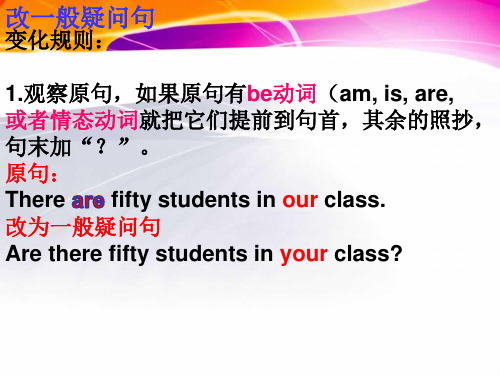
some 和any意思都是:一些 但是用法有区别。 some 用在肯定句,any用在否定句和疑问句。
There are some books in my bag.(肯定句) There are not any books in my bag.(否定句) Are there any books in your bag? (疑问句)
(5) Amy likes pears.
D_o__e_sAmy l_i_k_e_ ____ pears ?
改一般疑问句
变化规则:
2.如果句中没有be动词就用Do或Does。(动词是 原形用Do;动词是第三人称单数用Does; 原句: We like music. 改为一般疑问句 Do you like music? 原句 He likes art. 改为一般疑问句 Does he like art?
3.注意:改句时,第一人称改为第二人称:I am 改为 Are you; We are 改为 Are you; some改为any; do、does、后的动词改为原形。 句尾加问号。
把下列句子改为一般疑问句。
(1)I am a good student.
_A_r_e____ __y_o__u__ a good student?
(2) He can swim.
__C__a_n_____ __h__e______ swim?
(3) ngling _l_ik_e___ apples?
改一般疑问句
变化规则:
1.观察原句,如果原句有be动词(am, is, are, 或者情态动词就把它们提前到句首,其余的照抄, 句末加“?”。 原句: There fifty students in our class. 改为一般疑问句 Are there fifty students in your class?
小学英语语法基础知识大全教学讲解ppt

六、动词:动词的四种时态 (1) 一般现在时: 一般现在时的构成 1. be动词:主语+be(am, is, are)+其它。如:I am a boy. 我是一个男孩。 2. 行为动词:主语+行为动词(+其它)。如:We study English. 我们学习英语。 当主语为第三人称单数(he, she, it)时,要在动词后加"-s"或"-es"。如:Mary likes Chinese.玛丽喜欢汉语。
序数词
(1) 一般在基数词后加th
four→fourth,thirteen→thirteenth
(2) 不规则变化
one→first,two→second,three→third,five→fifth,eight→eighth,nine→ninth, twelve—twelfth
(3) 以y结尾的十位整数,变y为ie再加th
4. 以“f或fe”结尾,变f或fe为v, 再加-es,如:knife-knives
5. 不规则名词复数: man-men, woman-women, policeman-policemen, policewoman-policewomen, mousemice child-children, foot-feet, tooth-teeth, fish-fish, people-people, Chinese-Chinese, Japanese-Japanese
A、规则动词
① 一般直接在动词的后面加ed:如 worked , learned , cleaned , visited ② 以e结尾的动词直接加d:如 lived , danced , used ③ 以辅音字母加y结尾的动词要改y为i再加ed(此类动词较少) 如 study – studied carry – carried worry – worried (注意play、stay不是辅音字母加y,所以不属于此类) ④ 双写最后一个字母(此类动词较少)如 stopped
小学英语语法_一般疑问句和特殊疑问句

(2)确定助动词用do、does还是did,根据句中动 词,动词是原形的助动词就用do,动词是第三人称 单数的助动词就用does,动词用过去式的助动词就 有did。 (3)把助动词后提到句首。 (4)原句中动词假如发生变化就要恢复成原形。 强调一点,有some的要考虑是否要用any。
特殊疑问句
表示疑问,有疑问词(在开头),回答有很多种可能。 常用疑问词: When 什么时间 问时间 What time 什么时间 问具体时间,如几点钟 Who 谁 问人 Whose 谁的 问主人 Where 在哪里 问地点 Which 哪一个 问选择 Why 为什么 问原因 What 什么 问东西、事物 What colour 什么颜色 问颜色 What about 。。。。怎么样 问意见 What day 星期几 问星期几
小学英语语法知识(一般疑问句)
一般疑问句:
表示疑问,一般回答只有两种可能Yes,……或 No,……句中没有疑问词。
如何将一个肯定的陈述句改为否定句:
1、看句中有无be动词,如有,把be动词提到句首即 可。
2、看句中有无情态动词,如有,把情态动词提到句首 即可。
3、如上述二者都没有,就应把助动提到句首。分四 个步骤:
not 例句:He is Tom. He is not Tom.
2、如句子里是动词就在这些词前加 don't,doesn't,didn't (1)主语是第一、二人称(复数)加don‘tபைடு நூலகம்第三人称单数加
doesn't (2)如果是过去式就加didn't 例句:I like dogs. I don‘t like dogs.
人教版小学四年级英语下册一般疑问句和特殊疑问句知识精讲

人教版小学四年级英语下册一般疑问句和特殊疑问句知识精讲Document serial number【UU89WT-UU98YT-UU8CB-UUUT-UUT108】PEP小学四年级英语下册《一般疑问句和特殊疑问句知识精讲》(一)疑问句可再分为一般疑问和特殊疑问两种。
(一).一般疑问:用be或助动词或情态动词置于句首,并以肯定回答“Yes,…”,或否定回答“No,…”或相当于yes / no回答的问句称为一般疑问句.1. 含系动词be的一般疑问句的构成具体地说,am 只能跟在第一人称的单数 I 后面,are 搭配 you ,we ,they等, ,is 跟在第三人称单数 he, she ,it后面,而be 动词的基本意思:是如:This is my computer. →Is this your computer (如遇第一人称,最好将其置换成第二人称,即将“我的”要换成“你的”) It's a map. →Is it a map而对于一般疑问句和特殊疑问句的回答分为两种,即肯定回答和否定回答。
如:Is it your bike肯定回答:Yes, it is.否定回答:No, it isn’t.Are they your shoes肯定回答:Yes, they are.否定回答:No, they are n’t.2.含助动词Do或Does的一般疑问句的构成Do与you,I,we连用,Does与he,she和it连用。
如:Do you have lunch at school肯定回答:Yes, I do.否定回答:No, I don’t.3. 含情态动词的一般疑问句的构成一般疑问句面前人人平等:情态动词与am / is / are一样,也可直接将它们提至主语前,所以问题迎刃而解了。
如:I can do it. →Can you do it肯定回答:Yes,I can.否定回答:No, I can’t.(记住在改成一般疑问句时应该将第一人称改成第二人称)Can I wear my new shirt today肯定回答:Yes,you can.否定回答:No, you can’t.4. 小插曲:一般疑问句的语调大部分的一般疑问句都应读作升调(↗),并落在最后一个单词身上。
小学英语语法——一般疑问句
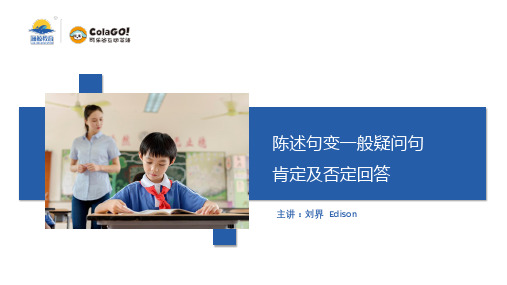
03.I am a student. 一般疑问句就是: Are you a student? 肯定回答:Yes, I am. 否定回答:No, I’m not. 04.We can help you. 一般疑问句就是: Can we help you? 肯定回答:Yes, we can. 否定回答:No, we can’t.
08.He can play basketball.
Can he play basketball?
肯定回答:Yes, he can.
否定回答:No, he can’t.
09. He is crying under the tree.
Is he crying under the tree?
肯定回答:Yes, he is.
如果主语是I或是we的,一般疑问句一般情况下要把人 称改为you。反之you要改成I,we,me或us。
01.His father is an English teacher.
Is his father an English teacher?
肯定回答:Yes, he is.
பைடு நூலகம்
否定回答: No, he isn’t.
02.They can swim. Can they swim?
肯定回答:Yes, they can. 否定回答: No, they can’t.
03.She is Jim’s mother.
Is she Jim’s mother?
肯定回答:Yes, she is.
否定回答: No, she isn’t.
陈述句变一般疑问句 肯定及否定回答
主讲:刘界 Edison
陈述句变为一般疑问句,首先看句中有没有系动词be或情态动词,如 果有,把be或情态动词直接提到句首就可以了;如果没有,要用助动 词do 或does 来帮助。基本句式如下: Be + 主语 +宾语 + 其他 + ? 情态动词 + 主语 + 谓语 + 宾语 + 其他 + ? Do(Does + 主语 + 谓语 + 宾语 + 其他 + ?
Be动词一般疑问句(课件)通用版小学英语
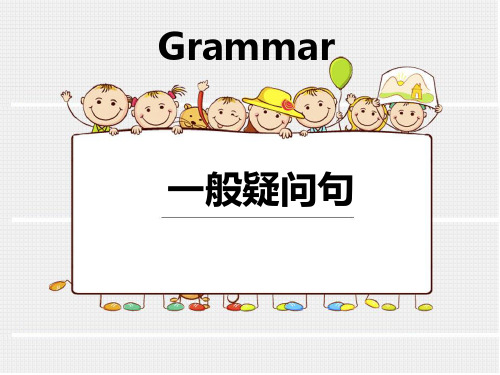
回答 is not are not am not
isn’t aren’t 没有缩写
回答
Is Peter a boy? Yes, he is.
写出下列单词对应的人称代词
1.Andy 2.Debbie 3.our friends 4.the desk 5.the teachers 6.the girl's book
Change them into general questions and answer.
1. His gloves are dirty. 2. My nose is big. 3. Billy is thin. 4. Her mother is hungry.
Translate.
1. 这是你的橡皮吗? 2. 他是我们的老师吗? 3. 你饿了吗? 4. 她高兴吗?
Judge.
5.Don't open the window. 6.Is she hungry? 7.He is tall.
变化方法
1.找到be动词并提前。 2.调整大小写。 3.句末加问号。
Change them into General Questions.
They are friends.
Fill in the blanks.
3.把一个含有be动词的句子变为一般 疑问句,第一步是_找_到__b_e动__词_并__提_前__, 第二步调__整_大__小_写_, 第三步_句__末_加__问_号___. 4.变一般疑问句时第一人称要变为 _第_二__人_称__.
I 变为__y_o_u_, our变为__y_o_u_r__.
I am a student.
变化方法
4.变问句时第一人称变为第二人称。
小学英语语法知识讲解一般疑问句的讲解

一般疑问句的讲解及练习一、什么是一般疑问句?以Be动词〔am is are〕,助动词〔do / does/ did / have/has〕,情态动词〔can/must/should〕开头的句子,而且用Yes或No来答复,读升调的句子就是一般疑问句。
译成汉语,都可以带上“吗〞,例如上面三句可分别译为:例:1〕Is your father a teacher? 你父亲是老师吗?2〕Catherine like animals? 凯瑟琳喜欢动物吗?3〕Jenny speak French? 詹妮会说法语吗?二、由陈述句变一般疑问句的规则:①第一步“找〞,看看句中有没有be动词〔am/is/are〕,助动词〔do/does/have/has〕,情态动词〔can/must/should〕这些词,如果有,就直接将这些词放在句子的开头,句末打上问号。
1〕找be动词〔am/is/are〕,如果有be动词,就把be 动词提到句子的第一位,其它局部照抄,把最后的句号变成问号。
②注意人称的变化:一变二,二变一,三不变,some变成any把句子的“我I〞换成〞你’you“我们we换成你们you我的my换成你们your我们的our换成你们的your〞some变成any③注意第一个首字母要大写,句子末尾的“句号.〞换成“问号?〞■由be动词引导的一般疑问句Be(am/is/are)+主语+其它+?肯定答复:Yes,主语代词+Be动词+句号否认答复:No,主语代词+be动词+not.例如:It is rainy today.→Is it rainy today?■由情态动词引导的一般疑问句:情态动词+主语+动词原形+其它+?〔1〕肯定答复:Yes,主语代词+情态动词+句点〔2〕否认答复:No,主语代词+情态动词+ not . 口诀:一提二换三照抄一提:将情态动词提到句子开头;二换:将第一人称换成第二人称;三照抄:陈述句剩下的都照抄例句:①Can you swim?Yes, I cna./No, I can not. ②Should I walk in the road?No, you should not.③We can playfootball.变成一般疑问句:Can you play football?④Tom's father can play the piano.→Can Tom's father play the piano?■如果句中有没有be动词〔am is are〕,助动词〔do does have has〕,情态动词〔can〕,则依据谓语动词的形式借助do 或does放句首。
- 1、下载文档前请自行甄别文档内容的完整性,平台不提供额外的编辑、内容补充、找答案等附加服务。
- 2、"仅部分预览"的文档,不可在线预览部分如存在完整性等问题,可反馈申请退款(可完整预览的文档不适用该条件!)。
- 3、如文档侵犯您的权益,请联系客服反馈,我们会尽快为您处理(人工客服工作时间:9:00-18:30)。
Eg1. 问句: Is she in the living room? 肯定回答: Yes,she is. 否定回答: No,she isn’t.
Eg2. 问句: Is this your uncle? 肯 定回答 : Yes ,it is.
否 定回答: No,it isn’t.
Eg3. 问句: Are they on the table? 肯定回答 : Yes ,they are. 否 定回答: No,they aren’t.
三问号:句末的句号改为问号。如:
Eg6. I am an English teacher. →
Are you an English teacher?
Eg7.This is my sister. →
பைடு நூலகம்
Is this your sister?
句型转换
1.This is my schoolbag. 2. She is very friendly. 3.He is in the bedroom.
.
一般疑问句有两个家族。
第一家族为含be动词或情态动词的一般疑问 句,其结构为:
be + 主语 + 其它部分
情态动词 + 主语 + 动词原形 + 其它部分
肯定回答用“Yes,主语+be\情态动词.”,否 定回答用“No,主语+be\情态动词+not.”。be或 情态动词和not可用缩写形式,主要有isn’t, aren’t,can’t等。
Eg4. 问句: Can you play football? 肯定回答: Yes,I can. 否定回答: No,I can’t.
Eg5. 问句: Would you like a knife and fork?
肯定回答: Yes,please .
否定回答: No,thanks.
朗读一般疑问句时用升调,而一般疑 问句的简略答语则用降调。
义隆永中心小学王晓华
一般说来,英语中共有四种问句,分别是一般疑 问句、特殊疑问句、选择疑问句和反意疑问句。 今天我们来学习一般疑问句。那么,什么是一般 疑问句呢?我们一起来听听一般疑问句的自白:
“Hello, 大家好!我是一般疑问句,我的天 性是爱发问。我最爱做的事是询问某种情况是否 属实,您不对我做出肯定或否定回答我是不会罢 休的。您也可用肢体语言来打发我,比如点头或 者摇头。所以我有一对好朋友,猜猜是什么?对 了,YES 和 NO!”
根据一般疑问句不同的家族,可以 用不同的方法将陈述句变为相应的一 般疑问句。
1、第一家族:含be动词或情态动词的句子
秘诀:一调二改三问号
一调:即把句中的be或情态动词调到主语前;
二改:改换主语称谓,即将句中的主语I\my \mine\we\our等第一人称分别改为相应的第二人 称you\your等;
